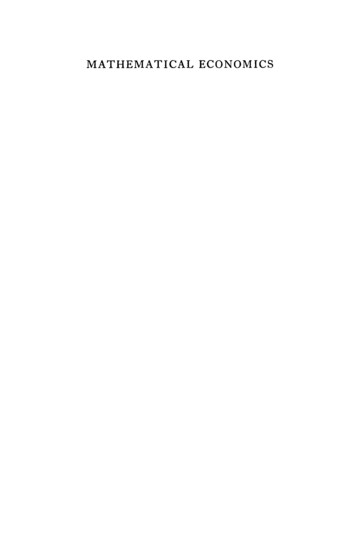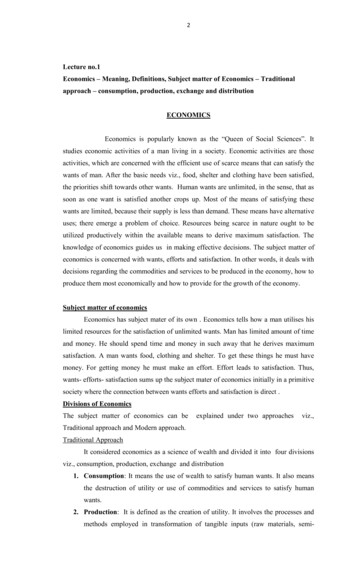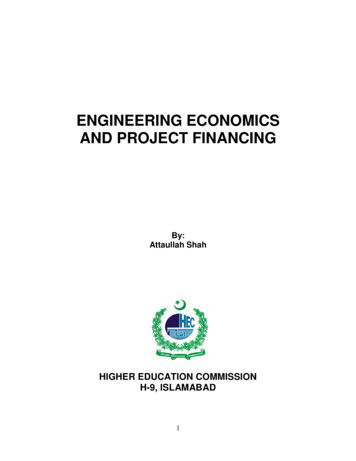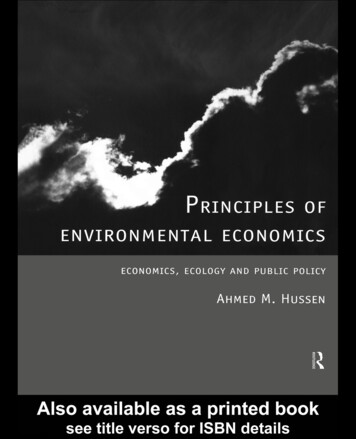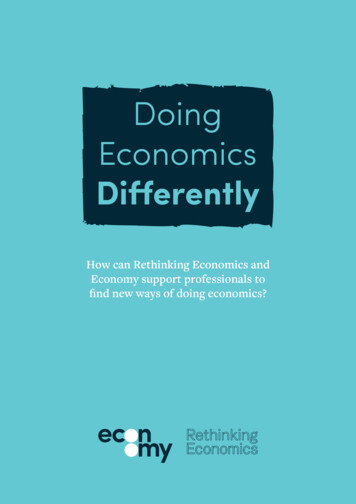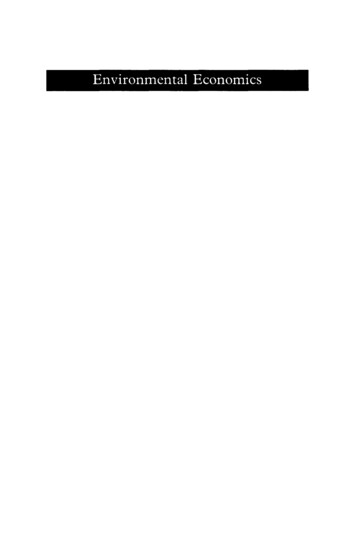
Transcription
Environmental Economics
MACMILLAN TEXTS IN ECONOMICSMacmillan Texts in Economics is a new generation of economicstextbooks from Macmillan developed in conjunction with a panel ofdistinguished editorial advisers:David Greenaway, Professor of Economics, University of NottinghamGordon Hughes, Professor of Political Economy, University of EdinburghDavid Pearce, Professor of Economics, University College LondonDavid Ulph, Professor of Economics, University College LondonPUBLISHEDPublic Sector Economics: Stephen J. BaileyUnderstanding the UK Economy (3rd edition): Edited by Peter CurwenBusiness Economics: Paul R. Ferguson, Glenys J. Ferguson andR. RothschildEnvironmental Economics in Theory and Practice: Nick Hanley,Jason F. Shogren and Ben WhiteInternational Finance: Keith PilbeamEconomics of the Labour Market: David Sapsford and.Zafiris TzannatosSeries Standing OrderIf you would like to receive future titles in this series as they are published, you canmake use of our standing order facility. To place a standing order please contactyour bookseller or, in case of difficulty, write to us at the address below with yourname and address and the name of the series. Please state with which title you wish tobegin your standing order. (If you live outside the United Kindgom we may not havethe rights for your area, in which case we will forward your order to the publisherconcerned.)Customer Services Department, Macmillan Distribution LtdHoundmills, Basingstoke, Hampshire RG21 6XS, England
ENVIRONMENTAL ECONOMICSIN THEORY AND PRACTICENick HanleyUniversity of StirlingJason F. ShogrenUniversity of WyomingandBen WhiteUniversity of Newcastle upon Tyne
Nick Hanley, Jason F. Shogren and Ben White 1997All rights reserved. No reproduction, copy or transmission ofthis publication may be made without written permission.No paragraph of this publication may be reproduced, copied ortransmitted save with written permission or in accordance withthe provisions of the Copyright, Designs and Patents Act 1988,or under terms of any licence permitting limited copyingissued by the Copyright Licencing Agency, 90 Tottenham CourtRoad, London WIP 9HE.Any person who does any unauthorised act in relation to thispublication may be liable to criminal prosecution and civilclaims for damages.First published 1997 byMACMILLAN PRESS LTDHoundmills, Basingstoke, Hampshire RG21 6XSand LondonCompanies and representativesthroughout the worldISBN 978-0-333-58235-0 hardcoverISBN 978-0-333-58236-7DOl 10.1007/978-1-349-24851-3ISBN 978-1-349-24851-3 (eBook)A catalogue record for this book is availablefrom the British LibraryThis book is printed on paper suitable for recycling andmade from fully managed and sustained forest sources.10069 97 605 04 03 025 401 003 2I99 98 97Typeset in Great Britain byAarontype Limited, Bristol, England
ContentsList of FiguresixList of TablesXlIxiiiIntroductionxvAcknowledgements1 The Economy and the Environment:Two Parts of a Whole1.1Introduction1.2Interlinkages between the economy and the environment1.3The first two laws of thermodynamics1.4ConclusionsTechnical note: game theory2 Market Failure2.1Introduction2.2Incomplete markets2.3Externalities2.4Non-exclusion and the commons2.5Non-rivalry and public goods2.6Non-convexities2.7Asymmetric information2.8Concluding comments3 Economic Incentives for Environmental Protection:An Overview3.1Introduction3.2Price rationing: charges and subsidies3.3Liability rules: non-compliance fees, bonds, anddeposit refunds3.4Quantity rationing: marketable permits3.5Evaluative criteria3.6Practical conditions for use of economic incentives3.7Concluding remarksTechnical note: mathematical 1959798
viContents4 Pollution Taxes for the Efficient Control of Pollution4.1Introduction4.2Efficiency properties of a tax on emissions4.3Problems with pollution taxes4.4Conclusions1061061071151285 Tradeable Pollution Permits5.1Introduction5.2The basic theory of tradeable pollution permits5.3Research issues in tradeable permit markets5.4Conclusions1301301301391556 Transboundary Pollution Problems6.1Introduction6.2Transboundary pollution as a problem of internationalexternalities6.3Transboundary pollution and game theory6.4Conclusions159159An Introduction to the Economics of NaturalResource Exploitation7.1Introduction7.2Elementary capital theory7.3The maximum principle of optimal control theory7.4The application of the maximum principle to specificfishery management problems7.5The discrete-time maximum principle and dynamicprogramming7.6Wiener processes, Ito's processes and stochastic calculus7.7Conclusions16316617378 Natural Resources: Types, Classification and Scarcity8.1Natural resource types and classification8.2Measuring resource scarcity8.3Conclusions9 An Economic Analysis of Non-renewableNatural Resources9.1Introduction9.2Market structure and the exploitation ofnon-renewable 7228
Contents vii9.39.49.5Production technology and extraction costsApplying the theoryGovernment policy towards non-renewableresource taxationUncertainty and the rate of resource extractionSummary24825810 Renewable Resource Economics10.1Introduction10.2 Population growth models10.3 Static models of fishery exploitation in continuous time10.4 Static economic models of fisheries10.5 Comparative dynamic models of fishing10.6 Fisheries policy10.7 Applying the theory and the discrete-time model10.8Extending the theoretical model10.9 Strategic behaviour in fishery management10.10 Fishing under uncertainty10.11 Summary27427427628128628829830330831332533211 The Economics of Forestry Exploitation11.1Introduction11.2 The principles of commercial forestry economics1l.3Multi-use forestry and the socially optimal forest rotation1l.4 Forestry land use and agriculture1l.5Forest policies1l.6 The optimal forest rotation under uncertainty1l. 7 Summary33533533634034335035235412 The Theory of Non-market Valuation12.1Introduction12.2 Measures of economic value12.3 Valuing risk and ex ante measures of value12.4 Issues in non-market valuation12.5Concluding comments35635635736837238113 Methods for Valuing Environmental Costsand Benefits13.1Introduction13.2 Direct methods of valuation13.3 Indirect methods of valuation13.4 Summary3833833844044189.69.7264266270
viiiContents14 The Economics of Sustainable Development14.1Introduction14.2 Possible sustainability rules14.3 Indicators of sustainability14.4 The Common-Perrings model of sustainable development425425426433443Index451
List of .73.83.93.103.114.14.24.3Economy-environment interactionsPossible damage functionsEnergy use to GDP ratios in four countriesNash equilibriumStackleberg equilibriumSocially optimal level of pollutionAlternative socially optimal levels of pollutionSocially and privately optimal level of pollutionCo-operative and non-co-operative self-protectionTotal cost of co-operative and non-co-operativeself-protectionOpen access and the prisoners' dilemmaCo-ordination gamePure public goodsSingle-peaked net benefit curveNon-convex marginal costsNon-convexity and the optimal level of pollutionMulti-peaked net benefit curveEnvironmental shirkingMoral hazardFeasible insurance contracts given moral hazardQuantity rationing of insuranceAdverse selectionSocially optimal level of pollution controlPrivately and socially optimal levels of outputCharges given uncertaintyOptimal levels of output given ambient chargeShort and long run impacts of a pollution taxShort and long run impacts of a pollution subsidyAsymmetric information and an environmental subsidySubsidy paid ignoring information rentsSubsidy paid accounting for information rentsQuantity rationing under uncertaintyMixed incentive systemMarginal abatement costs for a firmAn efficient tax on emissionsSavings under innovation with a pollution 657074757778798991109112119
xList of Figures4.4Savings under innovation, diffusion and regulatoryresponseFinancial burden of a pollution tax4.54.6A possible time path for a stock pollutant5.1Firm's optimal response to a permit scheme5.2Supply and demand for permitsPermit revenues and expenditures5.35.4Innovation in permit markets6.1Non-co-operative and full co-operative outcomes7.1Logistic growth curve7.2A phase-plane diagramTrajectory types7.37.4Phase-plane diagram showing stability analysis7.5Comparative dynamics and the steady-state solution7.6A dynamic programming problem7.7Fishery investment under uncertainty8.1Problems of defining 'reserves'8.2The mineralogical threshold9.1Comparative dynamics for costless extraction undercompetition and monopoly9.2Monopoly rent, current value9.3Monopoly rent, present value9.4Price path for the Nash-Coumot solution to the cartelproblem9.5Quantity path for the Nash-Coumot solution to thecartel problemVon Stackelberg equilibrium9.69.7Extraction costs9.8Time paths for the shadow price of a resource10.1 The logistic growth curve10.2 Growth curve showing depensation10.3 A simple population cycle10.4 Ricker curves10.5 The effect of harvesting on population change10.6 Equilibrium between fishing effort and the stock10.7 Equilibrium between fishing effort and the catch10.8 Equilibrium between fishing effort and the stock withcritical depensation10.9 Equilibrium between fishing effort and the catch withcritical depensation10.10 Static fishing equilibria10.11 Equilibrium stock and the number of firms10.12 Equilibrium shadow price against the number of 3283284287294294
List of Figures10.13 Phase-plane representation of the sole-ownership 1.311.411.512.112.212.312.412.513.114.1with an endogenous priceBioeconomic equilibrium in the harp seal populationOptimal harvest and investmentPay-off setsPay-off possibility setsNash bargaining solutionSteady-state equilibria in a fish warStochastic stock recruitmentTree growth functionComparative statics for the Faustmann rotationGrazing benefit functionOptimal Hartman rotationThe effect of a yield tax on the Faustmann rotationPreferences, utility and consumer surplusWTP for improved environmental servicesWTP and WTA given perfect and imperfectsubstitutabilityWTP and WTA measures of value, given an environmenthazardValue formation and preference learningHedonic price measures of valueSustainability versus 1358361363366377412433
List of .213.313.4Water quality levels and resource costsControl costs for air pollutionTax rates on greenhouse gasesNatural parameters for greenhouse gasesAbatement costs and emission reductions under differentoffset rulesCost savings under sequential tradingConditions for stability in systems of differential equationsWorld reserves, reserve bases and crustal abundances ofselected mineralsStudies of non-renewable resource scarcityEstimates for the output equationThe bionomic optimumPay-off matrixEffects of more information on WTP to preserve heathsDescription of variables for analysisDeterminants of real consumer surplus per lDit of useDemand curve for broadleaved 411415
IntroductionThis book is aimed at final-year undergraduates in environmental andresource economics, graduate students and professionals. It provides a guideto the most important areas of natural resource and environmentaleconomics: the economics of non-renewable and renewable resourceextraction, the economics of pollution control, the application of costbenefit analysis to the environment and the economics of sustainabledevelopment. However we cannot claim that all interesting areas of thesubject are represented here. For example, the reader will find very little ondistributional issues, on trade and the environment, or recycling and solidwaste management. Reasons for omissions include the size and cost of theresultant volume. We have, instead, concentrated on those parts of theorywhich we find most interesting and have tried to show how this theory canbe applied to real-world problems. Thus, for example, Chapter 12 considersthe theory of environmental valuation, while Chapter 13 explains howvaluation is actually done.Throughout the book, results are presented in words, in figures and moreformally using mathematical models. To aid this exposition, brief 'technicalnotes' inform readers about the Kuhn-Tucker conditions, game theory andlinear programming. The book progresses through the laws of thermodynamics to an analysis of market failure. The economics of pollutioncontrol are then considered. Natural resources are the subject of the nextsection, and the book closes with an examination of environmental costbenefit analysis and sustainable development.All of the authors have been involved in teaching courses in environmental and natural resource economics to both undergraduates andgraduates in Britain and North America, so we hope that some benefithas been gained from this experience which will in tum aid readers of thisbook. We have also sought to include material from areas of our ownresearch, emphasising the beneficial links between teaching and research.This book started life in 1991, and so has been a long time in the making.We would therefore first like to thank Stephen Rutt of the Macmillan Pressfor his patience and fortitude. Vic Adamowicz deserves a very big thankyou for reading over many draft chapters and providing comments: thanks,Vic. Nick Hanley also would like to thank many people for helpfulcomments on draft chapters, and for trying to explain the subject to him. Inno particular order, these people include Mick Common, Charles Perrings,Jim Shortie, John Hartwick, David Pearce, Kerry Turner, Jack Pezzey,Xlll
xiv IntroductionAlistair Munro, John Haynes and Clive Spash. Thanks also to Paul Gill forthe box sections in Chapter 14, David Parsisson for drawing Nick'sdiagrams on his Apple and Jenny Milne for compiling the contents pages.Finally, thanks to Fanny Missfeldt for co-authoring Chapter 6 with me. JayShogren would like to thank Tom Crocker, Bruce Forster, Todd Sandlerand Joe Kenkuliet. Ben White would like to thank Tim Masters for readingparts of his section and Caroline Saunders for useful discussions on nonrenewable resources, Caroline Faddy for secretarial assistance and his wifeJane for encouragement and support.This book is dedicated to our families: Kate, Rose and Charlie; Deb,Riley and Maija; and Jane, Catherine and Steven.
Aclznow ledgemen tsThe authors and publishers wish to thank the following for permission touse copyright material:Academic Press, Inc. for Figure 4.4 from Scott Milliman and Raymond Prince(1989) 'Firm incentives to promote technical change in pollution control',Journal of Environmental Economics and Management, 17, pp.245-65; andFigure 3.4 adapted from R. Cabe and J. Herriges (1992) 'The regulation ofnon-point sources of pollution under imperfect and asymmetric information',Journal of Environmental Economics and Management, 22, 134-46;American Agricultural Economic Association for Tables 13.2 and 13.3 fromV.K. Smith and W. Kauru (1990) 'Signals or noise? Explaining the variationin recreation benefit estimates', American Journal of Agricultural Economics,May, 419-33;American Scientist for Figure 8.2 from B. Skinner (1976) 'A second ironage?', American Scientist, 64, 258-269;Kluwer Academic Publishers for Tables 4.3 and 4.4 from P. Michaelis(1992) 'Global warming: efficient policies in the case of multiple pollutants',Environmental and Resource Economics, 2, 61-78.Every effort has been made to trace all the copyright-holders, but if any havebeen inadvertently overlooked the publishers will be pleased to make thenecessary arrangement at the first opportunity.xv
x List of Figures 4.4 Savings under innovation, diffusion and regulatory response 120 4.5 Financial burden of a pollution tax 124 4.6 A possible time path for a stock pollutant 125 5.1 Firm's optimal response to a permit scheme 131 5.2 Supply and demand for permits 132 5.3 Permit revenues and expenditures 133 5.4 Innovation in permit markets 152 6.1 Non-co-operative and full co-operative .




